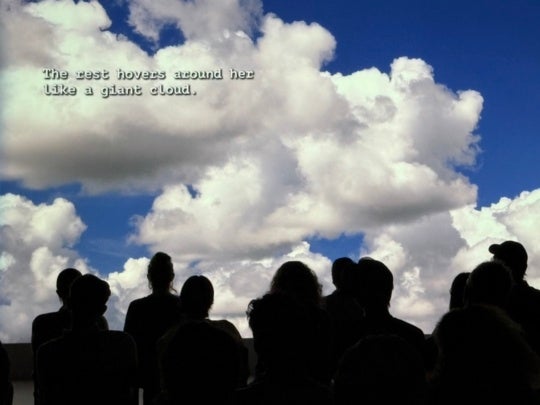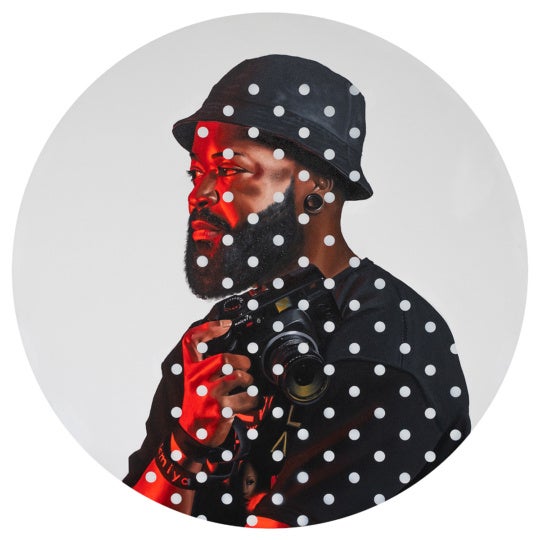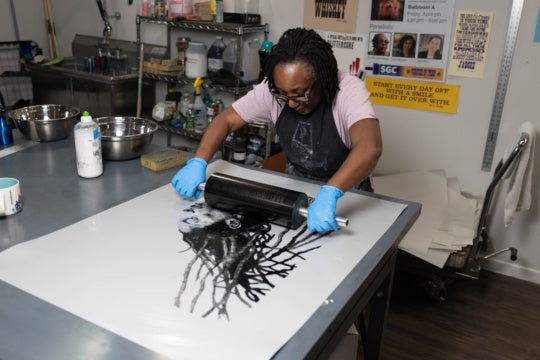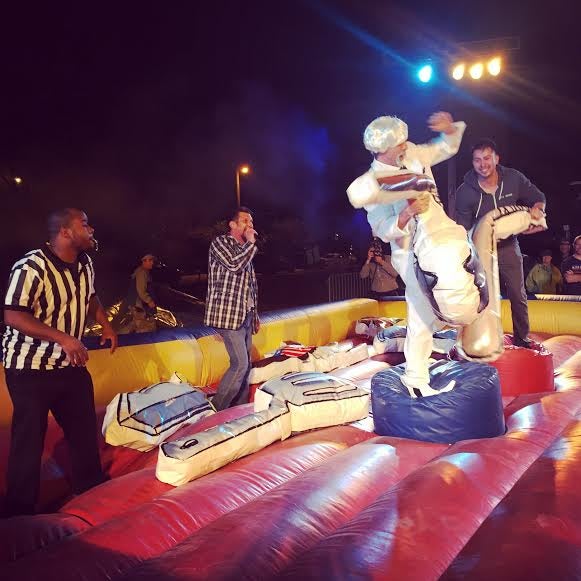
Flux Night flopped this year. One of my friends described it as “like going to the zoo, and all the animals are at the vet.” Bad weather, poor planning, and weak artistic choices hamstrung what was once one of the city’s most promising art events. Every visitor I talked to was disappointed, especially those who attended previous years.
This was the fifth Flux Night—the organization took a break in 2014 to regroup. Previously held in Castleberry Hill, where it was well attended but taking on the appearance of a block party, this iteration took place in the Old Fourth Ward with a budget almost a third more than 2013: $300,000 for the five-hour festival. The event was originally scheduled for October 3 but was cancelled due to the threat of rain. Unfortunately, the rescheduled date, November 7, was just as wet, but organizers decided to carry on with the festival. Despite having extra time to plan, the event was still plagued by technical and organizational difficulties.
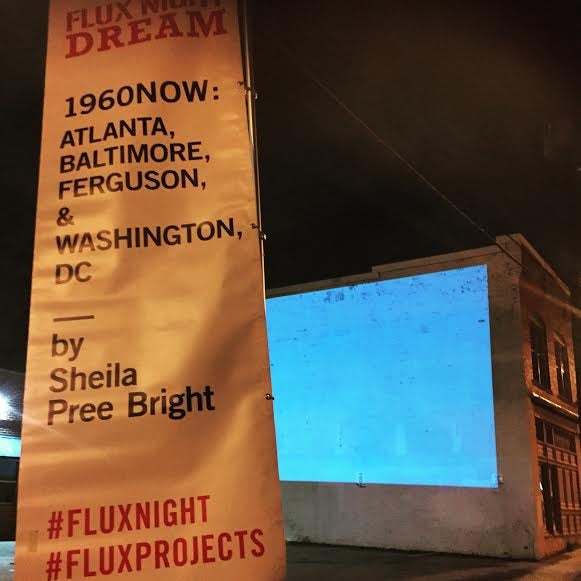
Flux Night began at 7pm. I made the full circuit at 9pm, and many of the pieces still were not functional. Light projections and videos had previously been some of the strongest installations at Flux Nights, but this year they failed significantly. Sheila Pree Bright’s photo projection on Edgewood was only a blank blue screen when I saw it.
Question Bridge: Black Males, a collective video project by Chris Johnson, Hank Willis Thomas, Bayeté Ross Smith, and Kamal Sinclair, was not running for the first half of the evening because the generator blew. The Center for Tactical Magic’s Freedom Fighter, a bouncy boxing ring with oversized, padded boxing equipment, took an extended break when the inflatable backdrop and projection screen sprang a leak and collapsed. When it was active, the piece was among the better offerings, with sporting attendees squaring off in the ring against fast-food mascots.
Center for Tactical Magic at Flux Night, Atlanta, 2015 from BURNAWAY on Vimeo.
Nato Thompson, the dynamic chief curator of Creative Time in New York City, was brought in to curate this year’s Flux Night. He found inspiration in the historic area around the King Center, and gave the “Dream” theme to Flux. Much of the artwork he selected was socially or politically engaging, a major difference from previous Flux Nights, which were more sensory-focused. Unfortunately, the vibrancy and energy of the old Flux Night was lost in this new vision.
“It was not a lighthearted show, and we knew that going in,” said Anne Archer Dennington, executive director of Flux Projects. “We had been criticized in the past for being a street party and not an art festival. It had become too fun and festive and not enough about being a critical art event.”
Thompson’s Flux Night addressed racial and economic disparity, transformed war into beauty, and walked viewers through Atlanta’s civil rights legacy. The Dream Lives by Stephon Ferguson was a King-family sanctioned recreation of the “I Have a Dream Speech.” This was one of the best pieces of the night, and it drew a huge crowd. It was a nice reminder of the historic legacy of the Old Fourth Ward, and it was moving to hear a classic speech that still resonates in today’s racially-divided political landscape.
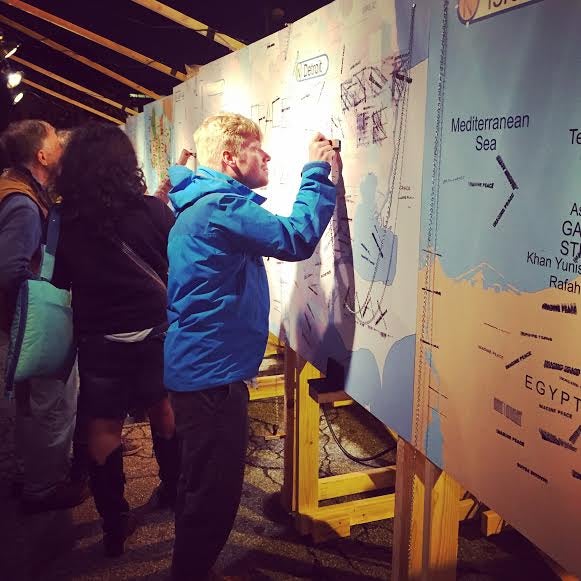
Yoko Ono’s Imagine Peace Maps allowed visitors to stamp the words “Imagine Peace” on different world maps. Disarm featured musical performances using decommissioned weapons as the instruments. While these were certainly thoughtful works, they were not nearly as engaging or interesting as expected.
In previous years, Flux Night was one of the most engaging art events I’d ever been to. The streets of Castleberry Hill were ignited with art installations, video projections, sound pieces, dancers, circus performers, molten lead manipulators … you name it. I remember watching a mesmerizing video by Monica Cook—a stop-motion movie of a chimpanzee figurine giving birth. Building-sized films, pop-up dance performances, and sound installations activated so many public spaces. Being able to pop into galleries and artist studios in Castleberry made the event even more special. The old Flux reinvigorated my love of art in Atlanta and made me feel this community was going places. In 2013, I left a beach vacation a day early to come see Flux—that’s how good it was. Even if it wasn’t politically revolutionary art, Flux was still fun to go to. In an effort to be a more meaningful art event, Flux lost its sense of joy.
Dennington stands by the festival and says that the goal is to create art that engages audiences and makes them think (or rethink) issues pertinent to their everyday life—not just be a party. “We want to be an organization that takes risks,” she says. “We want artists to try something they’ve never tried before. You could come here and test something and it could fail” and have that be okay.
In reality, Atlanta festival audiences don’t want to be challenged by artwork. They want to be able to walk through the streets with a drink, stopping occasionally to soak in strange sights. You can engage these festival-goers through art and inspire them to look at their world anew; however, don’t expect them to make it to midnight sober enough to participate in a social practice piece flown in from Oakland. I prefer the old, pretty, vapid Flux Night.
Matthew Terrell writes, photographs, and creates videos in the fine city of Atlanta. His work can be found regularly on the Huffington Post, where he covers such subjects as the queer history of the South, drag culture, and gay men’s health issues.

